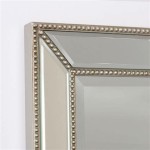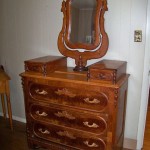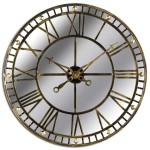Painting a Wooden Mirror Frame: A Step-by-Step Guide
A wooden mirror frame can be a beautiful and timeless addition to any room. However, over time, the frame may become chipped, scratched, or simply outdated. Painting a wooden mirror frame is an excellent way to refresh its look and give it a new lease on life. This process is relatively simple and affordable, requiring only a few basic tools and materials. This article will provide a comprehensive step-by-step guide on how to paint a wooden mirror frame, ensuring a successful and aesthetically pleasing outcome.
Preparing the Frame
The first step in painting a wooden mirror frame is proper preparation. This ensures that the paint adheres well and provides a smooth, even finish. Begin by removing the mirror from its frame. If possible, it's recommended to detach the mirror entirely to avoid potential damage or accidental paint splatters. Next, thoroughly clean the frame using a damp cloth and mild soap. Remove any dust, dirt, or grime that may hinder paint adhesion. Allow the frame to dry completely before proceeding.
Once the frame is clean, it's essential to address any existing imperfections, such as scratches, chips, or cracks. Sanding the frame with fine-grit sandpaper will smooth out these flaws and create a uniform surface for painting. For deeper imperfections, consider using wood filler to patch them before sanding. After sanding, wipe the frame with a damp cloth to remove any sanding dust. This step ensures that the paint adheres properly and allows for a smooth, even finish.
Choosing the Right Paint
The choice of paint for your mirror frame depends on the desired finish and the existing paint on the frame. If the frame has a glossy finish, consider using a primer to help the new paint adhere properly. For a classic look, consider using oil-based paint, which provides a durable and long-lasting finish. However, oil-based paints can have a strong odor and require longer drying times. Alternatively, latex paint offers a less pungent odor, quicker drying time, and is generally easier to clean up. If the frame has a distressed or weathered look, consider using chalk paint, which provides a matte, vintage-inspired finish.
When selecting the paint color, consider the surrounding décor and the overall aesthetic of the room. A bright, bold color can add a pop of energy to the space, while a neutral tone can create a calming and sophisticated ambience. For a dramatic effect, consider painting the frame in a contrasting color to the walls. If the frame is already painted, you might consider applying a coat of primer to ensure good adhesion before applying the new paint.
Painting the Frame
With the frame prepared and the paint selected, it's time to embark on the painting process. Begin by applying a layer of primer if necessary, following the manufacturer's instructions. Allow the primer to dry completely before proceeding with the actual paint. For a smooth and even finish, use a high-quality paintbrush. Apply thin, even coats of paint, working in a consistent direction. Allow each coat to dry completely before applying the next. The number of coats required will depend on the desired opacity and color depth.
After the final coat of paint has dried, consider applying a sealant to protect the frame from scratches and wear. Polyurethane sealant is a good option for high-traffic areas, providing a durable and water-resistant finish. However, sealant can alter the appearance of the paint, making it slightly glossier. If a matte finish is desired, consider using a clear acrylic sealant instead.
Adding Finishing Touches
Once the paint is dry and sealed, you can add finishing touches to enhance the look of the mirror frame. For example, you can distress the paint to create a rustic or vintage feel. This is achieved by lightly sanding the edges of the frame, revealing the underlying wood. Alternatively, you can apply a glaze to the frame for a more sophisticated and elegant look. Depending on the desired effect, different glazes can be applied to create a range of finishes, from subtle highlights to dramatic depth.
Another finishing touch option is to add decorative accents to the frame. This could include adding metallic accents with gold leaf, stenciling patterns, or utilizing decoupage techniques. These embellishments can further personalize the frame and make it truly unique.
After adding any desired finishing touches, carefully reattach the mirror to the frame using screws or glue, ensuring a secure and stable fit. Once the mirror is back in place, step back and admire your freshly painted frame. The transformation will surely enhance the overall look of the mirror and add a touch of personalized flair to your space.

Painting A Mirror Frame Easy Yet Stunning Ideas Girl In The Garage

How To Paint A Wooden Mirror Frame My Repurposed Life

Tutorial Create The Weathered Wood Look With Paint Transform A Mirror

Painted Mirror Using Paint Glaze To Enhance Details Sand And Sisal

How To Paint A Mirror Frame Antique White Well Purposed Woman

How To Paint A Mirror Frame The Easy Way By Just Woods

How To Paint A Mirror Frame Furniture Flipping Mirrors

Painting A Mirror Frame Easy Yet Stunning Ideas Frames Inspiration

Painting A Mirror Frame Easy Yet Stunning Ideas Girl In The Garage

How To Paint A Mirror Frame The Easy Way By Just Woods








